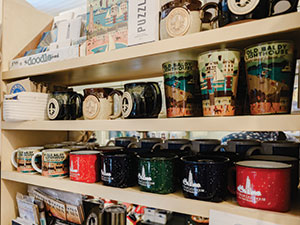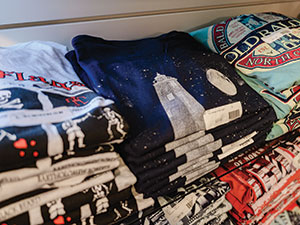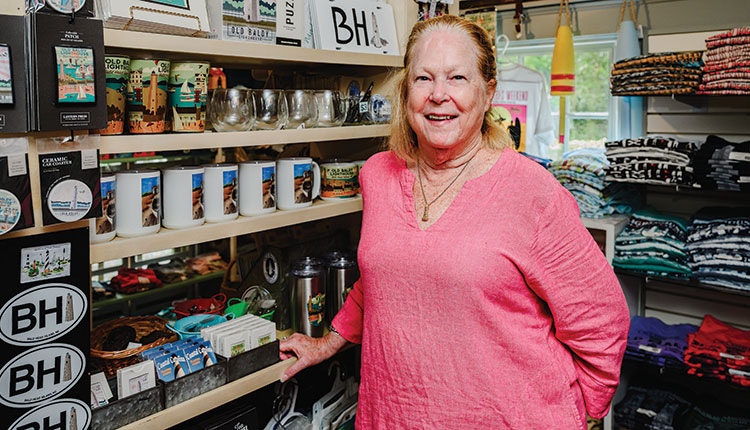Inside Old Baldy Lighthouse Museum Gift Shop, souvenirs do more than tell a story — they help.
Where the Cape Fear River meets the Atlantic, a lighthouse stands sentry over shifting sands and stories of ship captains and swashbuckling pirates. Old Baldy, built in 1817, is North Carolina’s oldest standing lighthouse — a rugged, mottled structure with stucco sides that have endured two centuries of wind and salt. It’s a place where nature and nostalgia intersect.
While Old Baldy has been out of service since 1935 — serving as a radio beacon until 1958 — this National Register of Historic Places monument still beams with energy and is relevant as a living history site.
Visitors climb its 108 steps for sweeping views of Bald Head Island, tour the Smith Island Museum of History next door to learn about shipwrecks and lighthouse keepers, and wander through the small but mighty Old Baldy Lighthouse Museum Gift Shop, where every sale supports the preservation of this maritime landmark.
The clapboard-style keeper’s cottage at the base of the lighthouse was reconstructed in 2000 to resemble the modest home that once stood beside the tower. Inside, the museum store’s 180-square-foot footprint is brimming with inventive displays that make the most of every inch — without feeling cluttered.
“Our store and admissions revenue keep the ship sailing,” says Chris Webb, executive director of the Old Baldy Foundation. Proceeds cover payroll, maintenance and educational programs.
Old Baldy has weathered hurricanes, erosion and centuries of change, yet it endures thanks to Webb, her dedicated team and the visitors who carry a piece of that legacy home — in a mug, puzzle or pirate doll.
“Every sale matters,” Webb emphasizes. “Every purchase helps us preserve this place. The light may no longer guide ships, but it still shines in everything we do.”
A maritime mixThe product selection speaks directly to the lighthouse’s maritime mission. “We try very hard to do as many custom items as we can,” Webb explains. “People like to buy things with Old Baldy on them.”
 Stoneware mugs featuring the lighthouse or island name drop line the shelves of the gift shop. Photos: Andrew Miller Shelves are lined with stoneware mugs from Sunset Hill Stoneware, T-shirts and hoodies from High Range Designs, Artisans Inc., Graphic Attack and American Backcountry, and puzzles featuring custom island photography produced by Heritage Puzzle.
“We stay within our theme — nautical, historical, or pirate-related — because there’s a long history of pirates here on the island,” Webb adds.
The shop carries Channel Craft’s traditional games like Captain Morgan’s Revenge and Rum Line, plus retro favorites such as Lincoln Logs in canvas bags. “We like games that feel timeless — things that connect families across generations,” says Webb.
Games extend to, “I’m a Pirate” and “I’m a Mermaid” sets by Madd Capp Games, and plush by Ganz moves fast with young tourists reaching for Raggedy Ann pirate dolls, parrots and an array of stuffed animals.
To keep displays fresh, Webb repurposes furniture and fixtures. “We also use slat wall, and this year we squeezed in a freestanding display from Lantern Press,” she says. “It increased the visibility of impulse buys and includes magnet panels. Our magnets are great sellers.” Those also come from Mill Wood Art.
One of the store’s most popular expansions has been its book corner. “We realized homeowners and vacation renters wanted beach reads and regional history,” says Webb. The result is a mix of Nicholas Sparks paperbacks, Southern cookbooks and volumes on maritime history.
Managing the wavesOld Baldy welcomes about 30,000 visitors each year, including more than a thousand fourth graders who take field trips to the lighthouse museum as part of their North Carolina history studies. The surge of small guests flows into the gift shop in groups of 20 so “the shop isn’t overwhelmed,” Webb says.
Tourism drives most sales at the shop and summer is prime time. But Webb says September and October are also quite steady. “I call it ‘baby month,’ when grandparents, parents and toddlers visit together,” she says.
Families take advantage of lessened crowds once school-aged children are back to the books. “Shoulder seasons are getting stronger,” Webb adds.
With waves of visitors throughout the year, managing inventory to keep shelves fully stocked requires constant coordination and a shuffle between multiple storage locations. Those include the cottage attic; a porch converted into an office; and an off-site warehouse about a five-minute golf cart ride away.
On Bald Head Island, forget mini vans to schlep boxes or pickup trucks to haul loads. The pedestrian-only island, reachable by ferry, is for walkers, bicycle riders and golf carts.
“When we do custom items like puzzles or ornaments, minimum orders can be 500,” Webb explains. “You need somewhere to put them.”
 Souvenir shirts can be found neatly folded along slat wall in the store, with many tees bearing a name drop or lighthouse. Restocking can be a shuffle, especially in high season. “It’s hard to keep every T-shirt size on the shelf,” says Webb, noting that updating the shop’s systems has eased this pain. “We rely on our point-of-sale system to know what’s where.”
Logistics extends to staffing.
“Every one of my employees commutes across the Cape Fear River,” Webb says. “It takes a special kind of person who wants to be part of this. We pay for their parking and ferry passes. Most of my staff have history backgrounds, which is fitting because there aren’t many full-time jobs with benefits for historians in this area, so this place attracts them.”
Mission in motion Beyond retail, the Foundation operates tours, educational programs and events that bring history to life. Webb says her team includes an educator who also manages collections; a communications coordinator for social media and outreach; and a visitor and museum services coordinator.
Each winter, when island traffic slows, the team closes for maintenance. “January and February are our downtime,” Webb says. “We clean, refresh displays and plan for spring. It’s also when we order new merchandise.”
Webb says she finds daily joy in the rhythm of the work.
“I’m 70 and a widow — if I were retired, I’m not sure what I’d do,” she reflects. “I love my staff; they’re young, smart, energetic. I get to work with people who care deeply about history. That keeps me going.”
|



